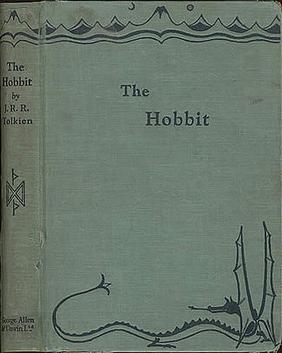The Hobbit
The Hobbit is a fantasy novel written by J.R.R. Tolkien. It was first published on 21 September 1937 and has since become a classic in children's literature. The story is set in a time "between the Dawn of Færie and the Dominion of Men," and follows the quest of home-loving hobbit Bilbo Baggins to win a share of the treasure guarded by the dragon Smaug. The novel is notable for its detailed world-building and the introduction of many characters and places that would later appear in The Lord of the Rings.
Plot Summary[edit | edit source]
The story begins in the Shire, where Bilbo Baggins lives a quiet and contented life. One day, he is visited by the wizard Gandalf and a group of thirteen dwarves led by Thorin Oakenshield. They invite Bilbo to join them on a quest to reclaim the Lonely Mountain and its treasure from the dragon Smaug. Despite his initial reluctance, Bilbo agrees to join the adventure.
Throughout their journey, the company encounters various challenges and adversaries, including trolls, goblins, wargs, and giant spiders. Bilbo also finds a magical ring that grants him the power of invisibility, which he uses to great effect throughout the story. This ring is later revealed to be the One Ring, a central element in The Lord of the Rings.
The climax of the story occurs when Bilbo and the dwarves reach the Lonely Mountain. Bilbo manages to steal a cup from Smaug's hoard, which enrages the dragon. Smaug flies out to attack the nearby Lake-town, where he is eventually killed by Bard the Bowman. The death of Smaug leads to a conflict over the treasure, involving the dwarves, elves, and men. The story concludes with the Battle of Five Armies, where the forces of good unite to defeat a common enemy.
Characters[edit | edit source]
- Bilbo Baggins - The protagonist, a hobbit who becomes an unlikely hero.
- Gandalf - A wizard who orchestrates the adventure.
- Thorin Oakenshield - Leader of the dwarves, heir to the throne of the Lonely Mountain.
- Smaug - The dragon who guards the treasure.
- Bard the Bowman - The man who kills Smaug.
- Gollum - A creature who possesses the One Ring before Bilbo.
Themes[edit | edit source]
The Hobbit explores several themes, including the hero's journey, the conflict between good and evil, and the importance of courage and friendship. The novel also delves into the idea of personal growth, as Bilbo transforms from a timid hobbit into a brave and resourceful hero.
Adaptations[edit | edit source]
The Hobbit has been adapted into various forms of media, including animated films, live-action movies, and stage productions. The most notable adaptation is the film trilogy directed by Peter Jackson, which was released between 2012 and 2014.
Related Pages[edit | edit source]
Categories[edit | edit source]
Search WikiMD
Ad.Tired of being Overweight? Try W8MD's physician weight loss program.
Semaglutide (Ozempic / Wegovy and Tirzepatide (Mounjaro / Zepbound) available.
Advertise on WikiMD
|
WikiMD's Wellness Encyclopedia |
| Let Food Be Thy Medicine Medicine Thy Food - Hippocrates |
Translate this page: - East Asian
中文,
日本,
한국어,
South Asian
हिन्दी,
தமிழ்,
తెలుగు,
Urdu,
ಕನ್ನಡ,
Southeast Asian
Indonesian,
Vietnamese,
Thai,
မြန်မာဘာသာ,
বাংলা
European
español,
Deutsch,
français,
Greek,
português do Brasil,
polski,
română,
русский,
Nederlands,
norsk,
svenska,
suomi,
Italian
Middle Eastern & African
عربى,
Turkish,
Persian,
Hebrew,
Afrikaans,
isiZulu,
Kiswahili,
Other
Bulgarian,
Hungarian,
Czech,
Swedish,
മലയാളം,
मराठी,
ਪੰਜਾਬੀ,
ગુજરાતી,
Portuguese,
Ukrainian
Medical Disclaimer: WikiMD is not a substitute for professional medical advice. The information on WikiMD is provided as an information resource only, may be incorrect, outdated or misleading, and is not to be used or relied on for any diagnostic or treatment purposes. Please consult your health care provider before making any healthcare decisions or for guidance about a specific medical condition. WikiMD expressly disclaims responsibility, and shall have no liability, for any damages, loss, injury, or liability whatsoever suffered as a result of your reliance on the information contained in this site. By visiting this site you agree to the foregoing terms and conditions, which may from time to time be changed or supplemented by WikiMD. If you do not agree to the foregoing terms and conditions, you should not enter or use this site. See full disclaimer.
Credits:Most images are courtesy of Wikimedia commons, and templates, categories Wikipedia, licensed under CC BY SA or similar.
Contributors: Prab R. Tumpati, MD






